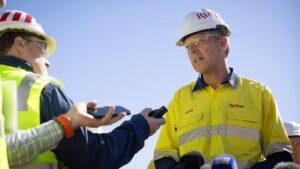Benchmark Mineral Intelligence: Why raw material supply is the big challenge for the lithium ion supply chain

Pic: RapidEye/iStock via Getty Images
- Benchmark Mineral Intelligence COO Andrew Miller says volatility in battery metals pricing in 2022 is a warning sign of the challenges to come in meeting accelerating EV demand projections
- Rio minerals boss Sinead Kaufman warns we’ll fall 50% short of the lithium required for the energy transition by 2030 even if every planned mine is developed
- Battery makers say metal prices and raw material availability are looming as major issues
Barnstorming prices for battery metals to feed the growing lithium ion supply chain in 2022 are just “warning signs” of the challenges to come to meet accelerating demand for EVs and energy storage amid the global energy transition.
That is the scenario laid out by Andrew Miller, the COO of battery metals price reporting agency Benchmark Mineral Intelligence at its Battery Gigafactories Asia Pacific Conference in Perth yesterday.
Lithium prices have soared to over US$70,000/t for chemicals in China, the EV supply chain’s biggest and most important market, with spot prices for spodumene concentrate from WA recorded at upwards of US$6000/t in recent weeks.
Nickel briefly spiked to over US$100,000/t on the LME amid an epic short squeeze in March in part resulting from an unexpected surge in demand for high purity nickel from the small but growing battery market.
“If we were here a couple of years ago, we probably wouldn’t have had the market signals that something major is happening,” he said.
“Rather than being sort of the end target of the industry, some of these market signs you’re seeing around lithium prices – major high spikes in lithium prices, turbulence in the nickel market – they are just indicators of what is to come in the supply chain and some of the challenges the raw material markets are going to face, certainly over the coming decade, as we push to meeting this major demand crisis.
“So this isn’t the end goal of the industry, these high prices we see today. I think people have to treat these as a warning sign of what’s still to come for the market, and for the various aspects of the supply chain over the years to come.”
He said battery demand growth will be in “double digits” for the foreseeable future.
“This year alone, we’re expecting the global demand for lithium ion batteries to grow by around 14% and if you contrast the market where it was last year at around 450 gigawatt hours,” Miller said.
“We expect that by the early 2030s that number will top 3000 gigawatt hours, so three terawatt hours of demand in the pipeline in a relatively short timeframe.”
Boom.
Lithium price not going to “collapse”
Some corners of the investment community [cough, Goldman Sachs, cough] think a collapse could be coming for lithium prices as production catches up to demand.
Miller thinks the market will slide closer to balance by the middle of this decade, while current prices could be unsustainable, but demand growth will be strong enough to ward off a more dramatic fall.
“We don’t think that price is falling off, we don’t think the market will allow it, the market’s tight through to the middle of the decade in our projections,” he said.
“So I don’t think we’re gonna see a massive fall off in pricing with spodumene and with your feedstock pricing where it is today.
“You have to consider that sets the precedent of where prices will be in the months to come.
“So I don’t think prices are going to fall off. I think you’ll see the rest of world pricing creep up towards China and maybe there’ll be a bit of an easing in the Chinese spot prices that you’ve seen throughout this year.”
Way more lithium needed
Rio Tinto’s (ASX:RIO) lithium boss Sinead Kaufman says it is underestimated just how much of the material needs to be mined by 2030 to keep pace with demand from EVs.
Unlike its biggest competitor BHP (ASX:BHP), the iron ore giant has decided to diversify into lithium via its stalled Jadar mine in Serbia and the US$825 million Rincon project in Argentina, which will be producing lithium carbonate from 2024.
“Battery materials in Rio has really been dedicated to trying to build at scale a portfolio of mining assets across lithium, but also other critical minerals and battery materials,” Kaufman said.
“And we see as others do an enormous demand for lithium as a building stock for lithium ion batteries. I mean, forecasts show that light electric vehicles will make up about 50% of the light vehicles on the road by 2030.
“Which means that lithium consumption, as Andrew said, needs to surge way above anything that’s currently been planned to be mined.
“With every project in the world that’s projected to come on, we’ll still be short by 50% of the amount of lithium that’s required to build the electric vehicles.”
The bottleneck is exaggerated by the fact that ESG credentials are becoming increasingly important for customers.
“Consumers today, they want to know where the product comes from. They also want to know all of the hands that it’s gone through to get to where it is, and I think the refining, the aspects of bringing that to market we’ve never seen more interest now than ever before on provenance,” she said.
“One of the parts of the portfolio for me in Rio Tinto is diamonds. We’ve done a lot of work over the years working on provenance and sustainability of diamonds and where they’ve come from.
“We’re seeing a similar level of interest now in what’s happening with critical minerals.”
Miller said the reality is we need more production now to meet ambition timeframes to electrify the transport sector, with automakers currently making multi-billion dollar investments to shift from ICE to EV production lines in line with community expectations and government policies.
“Ultimately lithium is one of the major limiting factors to how big that actual demand number ends up being,” he said.
“Fundamentally that demand is not going anywhere.
“So if we don’t have the lithium volumes we need this year, the push towards electrification will just be knocked back. And that’s the big risk the industry is not capturing that opportunity today, but it doesn’t mean that the opportunity is going away.”
The need for speed
The speed required to resource the transition to low carbon transport and electricity is prompting miners to look for ways to fast track what have become extremely long development and approval timelines both internally and with local authorities and communities.
The Indonesian nickel arm of Brazilian mining giant Vale, best known for being the world’s largest exporter of iron ore alongside Rio, is planning to bring 333,000t of new nickel products online in just three years.
That will help address acute shortages in the nickel market, where batteries will be the main factor in a surge in demand from ~2.5Mtpa to 4Mtpa by 2030.
At the centre of that will be two new HPAL and matte projects producing battery grade nickel normally supplied by sulphide miners in places like Australia, Russia and Canada.
Backed by an uncomfortable coalition of Chinese (Huayou Cobalt) and US (Ford) companies, it is a massive expansion in the world’s largest nickel producing nation, typically viewed as a supplier of cheap, low grade nickel pig iron.
Its first development, the US$4.3 billion Pomalaa HPAL plant has already been increased in scale from 40,000t to 120,000tpa due to demand from customers.
In total it is planning to invest up to US$8.6b in growing its portfolio, with US$2b committed to a 60,000tpa HPAL plant with Huayou alongside an 80,000t nickel matte plant at its Sorowako project and US$2.3b on the 80,000tpa Bahodopi RKEF line.
“This is something unusual, normally it takes years to study. Three years is nothing but now we have to execute this project in three years’ time,” PT Vale CEO Febriany Eddy said.
“An unprecedented shockwave of demand requires an unprecedented supply response.”
She said sustainability and reducing carbon emissions was a requirement for supplying nickel to the battery market, with PT Vale planning to reduce its Scope 1 and 2 emissions by 33% by 2030 and hit net zero by 2050.
High prices causing concern
Despite super high prices for lithium and other commodities, they are still being supported by super strong demand for EVs.
Electric vehicles remains a luxury item purchased by affluent early adopters, with the growth profile of the sector at the moment largely unconstrained by price.
That is providing a logic where lithium raw materials like spodumene can fetch as much as eight times their production cost at tender, as seen in the last Pilbara Minerals (ASX:PLS) Battery Materials Exchange auction.
But that is a concern for battery makers, who say that even as technology and scale brings down the production cost of lithium ion batteries, raw material prices are posing a challenge.
“Metal prices are now too high,” says Ryuta Tawaguchi, CTO of Japanese battery maker FREYR Battery.
He thinks that could place limitations on EV penetration in the mainstream passenger car market, something which could put the brakes on the energy transition.
“If these prices continue, it’s impossible to sell enough number of EVs because the EV is too expensive to penetrate. Maybe high end for luxury brand is okay, but not for mass volume EVs.
“So I can say EV is now US$10,000 more expensive than ICE. What is in our plan is next five years the battery cost is 50% reduced, but actually 50% more in current metal price.
“Someone needs to pay a lot, maybe the end user.”
Citing issues Tesla battery supplier Panasonic had hitting full production yields, Tawaguchi said it could take new battery cell makers longer than expected to become commercial.
He said more investment will be needed in both raw materials and technology to support demand for EVs.
Changing raw material strategies
But demand for lithium and other raw materials like graphite, nickel and cobalt continues to grow as battery makers ramp up in scale.
The strategy head of South Korean battery cell maker SK On Donghoe Gu said the company had previously focused its lithium procurement on long term contracts with major players, but may have to change track and lower its eyes to junior miners as it increases its production capacity.
“We are not a miner, we are not a processing player. So our optimal capital allocation is to still keep focusing on investing in manufacturing plants globally,” he said.
“But we also allocate our capital to source critical minerals.
“Previously we are focusing on the major players but the market is not easy right now. So we want to talk (to) junior minor players to source and to support our future growth.”
Related Topics

UNLOCK INSIGHTS
Discover the untold stories of emerging ASX stocks.
Daily news and expert analysis, it's free to subscribe.
By proceeding, you confirm you understand that we handle personal information in accordance with our Privacy Policy.








